It looks like you're using an Ad Blocker.
Please white-list or disable AboveTopSecret.com in your ad-blocking tool.
Thank you.
Some features of ATS will be disabled while you continue to use an ad-blocker.
21
share:
I just noticed the earthquake activity at Mt. Hood over the past few hours. According to the PNSN
Mount Hood page, there have been 17 small quakes just south of the volcano in the past 6 hours.
The largest was a Mag 1.7. The depths average around 6km.
We should keep an eye on it and see what develops.
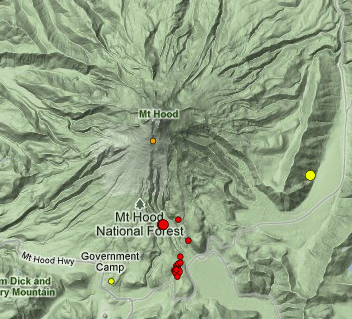
ETA: Although historically, over the past 40 years, Mt. Hood averages zero earthquakes per month, the seismologists at the Pacific Northwest Seismic Network say this activity is not unusual. Read their blog concerning this afternoon's swarm Here.
Sooo...doesn't sound like this is anything to be alarmed about. But if you would like to monitor the mountain, I find these stations good: TIMB, HOOD, and TDH. You can find them on the this page.

It looks like at least 4 more quakes have rumbled since the last PNSN update, 2 of which look to be near Mag 1.0 size. Tiny.
Mr. Malone, from PNSN, studied the swarms from the 1990s, and feels they are most likely from regional tectonic stresses; not volcanics--but they're watching closely.
We should keep an eye on it and see what develops.

ETA: Although historically, over the past 40 years, Mt. Hood averages zero earthquakes per month, the seismologists at the Pacific Northwest Seismic Network say this activity is not unusual. Read their blog concerning this afternoon's swarm Here.
Sooo...doesn't sound like this is anything to be alarmed about. But if you would like to monitor the mountain, I find these stations good: TIMB, HOOD, and TDH. You can find them on the this page.
edit on 2/23/2012
by Olivine because: add more info

It looks like at least 4 more quakes have rumbled since the last PNSN update, 2 of which look to be near Mag 1.0 size. Tiny.
Mr. Malone, from PNSN, studied the swarms from the 1990s, and feels they are most likely from regional tectonic stresses; not volcanics--but they're watching closely.
edit on 2/23/2012 by Olivine because: just adding a little more data
Yes small earthquakes are coming up especially the Mega quakes, just earth changes nothing to be afraid of but it would be good to be AWARE.
edit on 23-2-2012 by anthonygillespie2012 because: (no reason given)
Nice catch, Olivine.
I was lucky enough to have been informed from somewhere else about this.
I have been over heli data with spectrograph for HOOD, TIMB, VLL, VFP and TDH- and while there is this bit of seismicity, there doesn't appear to have been any tremor of any kind that I can see for all those stations back to 2-22.
But a swarm on Hood is always something to keep an eye on, so glad you posted it.
I was lucky enough to have been informed from somewhere else about this.
I have been over heli data with spectrograph for HOOD, TIMB, VLL, VFP and TDH- and while there is this bit of seismicity, there doesn't appear to have been any tremor of any kind that I can see for all those stations back to 2-22.
But a swarm on Hood is always something to keep an eye on, so glad you posted it.
edit on Thu Feb 23rd 2012 by TrueAmerican because: (no
reason given)
reply to post by TrueAmerican
I'm glad to have your eyes on this TA. Thanks. After reading the summary of the swarm from 1999, it seems these are probably tectonic in nature.
I just have to say, that zworld brought this to my attention, with his last post in the West Coast thread.
@ Zworld, I blew it. I was excited to start my first thread, and I really should have asked you to do the honors.
Please forgive my cloddish newbie ways.
I'm glad to have your eyes on this TA. Thanks. After reading the summary of the swarm from 1999, it seems these are probably tectonic in nature.
I just have to say, that zworld brought this to my attention, with his last post in the West Coast thread.
@ Zworld, I blew it. I was excited to start my first thread, and I really should have asked you to do the honors.
Please forgive my cloddish newbie ways.
Yeah sure, Oli, always happy to help.
Although after reading Steve Malone's "boring" assessment of these quakes, I do wonder why he would state that station TDH is the closest station to either Mt. Hood, or to the recent seismicity on the south flank. Because that is incorrect. HOOD is the closest to seismicity, TIMB is closer to seismicity and closest to peak, and TDH is well, aways away.
Just thought we'd clear that up.
And please, check me on that. Cause I did check.
Although after reading Steve Malone's "boring" assessment of these quakes, I do wonder why he would state that station TDH is the closest station to either Mt. Hood, or to the recent seismicity on the south flank. Because that is incorrect. HOOD is the closest to seismicity, TIMB is closer to seismicity and closest to peak, and TDH is well, aways away.
Just thought we'd clear that up.
And please, check me on that. Cause I did check.
edit on Thu Feb 23rd 2012 by TrueAmerican because: (no reason given)
Right after you posted, I too kept checking for information and could find none, However, at 8:36, here in the valley I felt rumbles and watched my
glass of water shake a little. It was really mild but definitely obvious.
I found this article of interest, describing how by comparison, Oregon has not been able to get as much funding for locating and studying fault lines as California, so there is much unknown here in our state when it comes to knowing all the fault lines.
www.oregonlive.com...
Peace,
spec
I found this article of interest, describing how by comparison, Oregon has not been able to get as much funding for locating and studying fault lines as California, so there is much unknown here in our state when it comes to knowing all the fault lines.
www.oregonlive.com...
Peace,
spec
reply to post by Olivine
This has me worried, why? Because I grew up in Portland Oregon, and had a great view of Mt. Hood from our living room. Anyway, back in 1980 when Mt. St. Helens blew her top/side, geologist were predicting that Mt. Hood had a 70% chance of blowing in the next 30-35 yrs. Well, guess what, that is now.
I've climb to the top of Mt. Hood, and near the top is what is called the "hogs back." It is a ridge that runs along a deep crevasse that smokes sometimes, and you get a lot of sulfur smell (from H2S) from it. So I always knew that Mt. Hood was not dormant. Will have to keep an eye on it.
This has me worried, why? Because I grew up in Portland Oregon, and had a great view of Mt. Hood from our living room. Anyway, back in 1980 when Mt. St. Helens blew her top/side, geologist were predicting that Mt. Hood had a 70% chance of blowing in the next 30-35 yrs. Well, guess what, that is now.
I've climb to the top of Mt. Hood, and near the top is what is called the "hogs back." It is a ridge that runs along a deep crevasse that smokes sometimes, and you get a lot of sulfur smell (from H2S) from it. So I always knew that Mt. Hood was not dormant. Will have to keep an eye on it.
Look at that animation and you will see how many quakes are occurring each hour off the coast of California and up in Alaska. To me that seems to be where the tension is being relieved in small doses. Off the coast of Oregon and British Columbia there aren't as many and to me that's where the tension is at it's worst right now.
reply to post by speculativeoptimist
Hi speculativeoptimist. Thanks for linking that article. It's really a darn shame that they have to scrounge for funding when lives are at stake. Especially disconcerting was the mention of hydroelectric dams. If one fails, that will be catastrophic for everyone down stream.
ETA: Your avatar is a hoot! Cute pup.
reply to post by fastfred
Thanks for posting your firsthand knowledge of the volcano fastfred. I had read that there are fumeroles on the mountain, but I didn't realize that the sulfur smell was so strong. Really interesting--I'm definitely going to do some more reading.
In Mt. Hood Earthquake Activity: Tectonic or Volcanic Origins? found here, the authors state that the very last known volcanic activity was between 1859-1865, when early settlers reporting seeing a glow from the summit.
reply to post by mark1167
Sweet .gif mark1167. Did you make that, or is it hidden on USGS and I just never noticed?
After reading the article linked above, the PNSN scientists are fairly certain these quakes are from normal mechanism faulting--the farthest north such Basin and Range type extensional faulting. But, (there always seems to be a "but") they hold out saying so with absolute certainty for a few reasons:
The 2002 swarm had a mainshock, followed by smaller aftershocks, indicating just your run-of the-mill fault rupture. Earlier swarms from the 1980's and 1990's (as well as this latest swarm) do not follow this pattern.
And, proximity to a historically active volcano.
Also interesting, during the number crunching of the 2002 swarm, they discovered a weak low-velocity zone at 4 km depth. (low-velocity zones can indicate an area of warm, possible molten rock)
I'm hoping they will analyze this latest swarm to see if the weak, slow zone is still there.
Hi speculativeoptimist. Thanks for linking that article. It's really a darn shame that they have to scrounge for funding when lives are at stake. Especially disconcerting was the mention of hydroelectric dams. If one fails, that will be catastrophic for everyone down stream.
ETA: Your avatar is a hoot! Cute pup.
reply to post by fastfred
Thanks for posting your firsthand knowledge of the volcano fastfred. I had read that there are fumeroles on the mountain, but I didn't realize that the sulfur smell was so strong. Really interesting--I'm definitely going to do some more reading.
In Mt. Hood Earthquake Activity: Tectonic or Volcanic Origins? found here, the authors state that the very last known volcanic activity was between 1859-1865, when early settlers reporting seeing a glow from the summit.
reply to post by mark1167
Sweet .gif mark1167. Did you make that, or is it hidden on USGS and I just never noticed?
After reading the article linked above, the PNSN scientists are fairly certain these quakes are from normal mechanism faulting--the farthest north such Basin and Range type extensional faulting. But, (there always seems to be a "but") they hold out saying so with absolute certainty for a few reasons:
The 2002 swarm had a mainshock, followed by smaller aftershocks, indicating just your run-of the-mill fault rupture. Earlier swarms from the 1980's and 1990's (as well as this latest swarm) do not follow this pattern.
And, proximity to a historically active volcano.
Also interesting, during the number crunching of the 2002 swarm, they discovered a weak low-velocity zone at 4 km depth. (low-velocity zones can indicate an area of warm, possible molten rock)
I'm hoping they will analyze this latest swarm to see if the weak, slow zone is still there.
edit on 2/24/2012 by Olivine because: edit
edit on 2/24/2012 by Olivine because: (no reason given)
reply to post by Olivine
If you go to their main page on the left hand column about three quarter's of the way down you'll see the option: "Earthquake animation". You'll find lots of really cool real time animation from all over the world . It's neat because you can see the way some earthquakes swarm in lines or almost semi circular formations in certain area's.
If you go to their main page on the left hand column about three quarter's of the way down you'll see the option: "Earthquake animation". You'll find lots of really cool real time animation from all over the world . It's neat because you can see the way some earthquakes swarm in lines or almost semi circular formations in certain area's.
It looks as if a new tiny earthquake swarm has begun at Mt. Hood. It started yesterday 8 March 2012 @ 06:03:31UTC with a Mag 0.6 and has produced 13
more small quakes since then, the largest being Mag 1.7.
Source--PNSN
This latest swarm looks to be on a parallel line to the west of the February cluster. I'll keep watching--if it picks up in size and/or intensity I'll report back.
ETA: I'm not sure why the link doesn't work, but once on the page, click Mt Hood from the column on the left
Mag Time (Local) (UTC) Depth (Km) (Miles)
1.7 2012/03/09 15:59:02 4.2
0.5 2012/03/09 09:08:59 2.8
0.6 2012/03/09 07:05:41 2.1
1.3 2012/03/09 06:38:06 5.1
0.8 2012/03/09 06:37:23 5.9
1.7 2012/03/09 06:36:58 3.9
0.0 2012/03/08 21:26:35 3.4
0.2 2012/03/08 20:44:11 3.5
0.3 2012/03/08 19:42:00 3.4
0.1 2012/03/08 19:40:40 2.8
0.6 2012/03/08 10:59:01 2.6
0.4 2012/03/08 10:49:04 2.2
0.2 2012/03/08 08:18:38 3.4
0.6 2012/03/08 06:03:31 3.4
Source--PNSN
This latest swarm looks to be on a parallel line to the west of the February cluster. I'll keep watching--if it picks up in size and/or intensity I'll report back.
edit on 3/9/2012 by Olivine because: (no reason given)
ETA: I'm not sure why the link doesn't work, but once on the page, click Mt Hood from the column on the left
edit on 3/9/2012 by Olivine
because: link instructions
Yet another swarm today. I noticed that the last swarm was on March 9, this one on April 9. Suspicious? Ha ha...
peace
17 quakes this time, the largest being a 2.7. Started yesterday around 8am my time (edt), so I guess 3 UTC? ...can't remember if it is plus or minus 5 for where I live.
peace
17 quakes this time, the largest being a 2.7. Started yesterday around 8am my time (edt), so I guess 3 UTC? ...can't remember if it is plus or minus 5 for where I live.
edit on 8-4-2012 by LobeDethFaurt because: more info
Thanks for posting LobeDethFaurt.
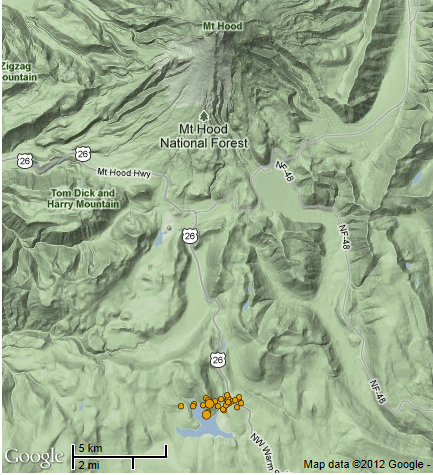
Map of swarm found on this page
This swarm is really curious.
It is 20 km south of Mt. Hood, which makes this activity too far away from the volcano to be associated with it, according to John Vidale, director PNSN. PNSN facebook link
Also noted on the FB discussion, was how little seismic activity is recorded in the PNSN catalog for this area.

Map of swarm found on this page
This swarm is really curious.
It is 20 km south of Mt. Hood, which makes this activity too far away from the volcano to be associated with it, according to John Vidale, director PNSN. PNSN facebook link
Also noted on the FB discussion, was how little seismic activity is recorded in the PNSN catalog for this area.
I was just checking on GPS velocities in the Oregon area, to see if there was any movement possibly connected with the current ETS event SW of Eugene,
when I noticed something odd at Mt. Hood.
Take a look at the Pacific Northwest Network velocity map. (the east-pointing arrow, just above the much longer NE arrow from South Sister)
This is Station P791 located low on the SE flank of the volcano.
Notice the spikes beginning after March 1st? (approximately--if I'm reading the hash marks properly)
This says it is experiencing 23.5mm/year movement. The swarms were located West of this station.
Just a short-term instrument malfunction, or something interesting? It looks to be returning to normal.
Take a look at the Pacific Northwest Network velocity map. (the east-pointing arrow, just above the much longer NE arrow from South Sister)
This is Station P791 located low on the SE flank of the volcano.
Notice the spikes beginning after March 1st? (approximately--if I'm reading the hash marks properly)
This says it is experiencing 23.5mm/year movement. The swarms were located West of this station.
Just a short-term instrument malfunction, or something interesting? It looks to be returning to normal.
It looks like Mt. Hood is becoming a bit fidgety--4 very small quakes over 20 minutes. Depths are from 2.6 to 6.3 km.

Source (you have to click "Mt. Hood", otherwise the link doesn't work for some reason)
This is station UW.TDH..SHZ old-style webicorder:
Here is the newer style webicorder found here

Edit before my 2 hours is up, lol. The total is up to 8 little quakes, with the depths now ranging between the 0 and 6.3km deep.
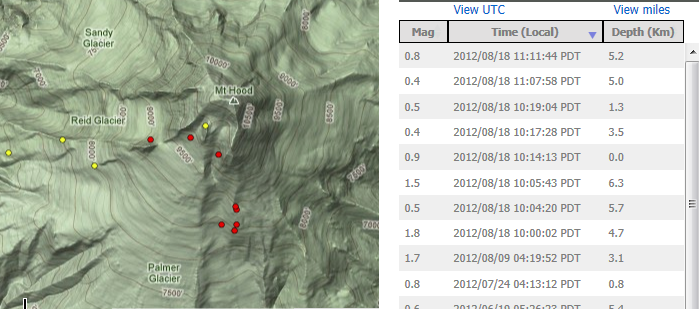

Source (you have to click "Mt. Hood", otherwise the link doesn't work for some reason)
This is station UW.TDH..SHZ old-style webicorder:
Here is the newer style webicorder found here

Edit before my 2 hours is up, lol. The total is up to 8 little quakes, with the depths now ranging between the 0 and 6.3km deep.

edit on 8/18/2012 by Olivine because: trying to fix link
edit on 8/18/2012 by Olivine because: updated map
reply to post by Olivine
Yep, thanks for the update.
And notice how those were relocated. I've had "eyes" on it since I saw your post, and I saw a couple more- but it appears to have subsided for now. Apparently these are common at Hood, and also they think they are tectonic in nature- not volcanic- even that shallow and directly under the mountain. The more I read the more I realize that tectonics play a critical part in the formation of volcanoes- and it's another reason why it's a specialty to be able to distinguish the different kinds of quakes from the calculated focal mechanisms.
Easy to get Hoodwinked at Hood.
Yep, thanks for the update.
And notice how those were relocated. I've had "eyes" on it since I saw your post, and I saw a couple more- but it appears to have subsided for now. Apparently these are common at Hood, and also they think they are tectonic in nature- not volcanic- even that shallow and directly under the mountain. The more I read the more I realize that tectonics play a critical part in the formation of volcanoes- and it's another reason why it's a specialty to be able to distinguish the different kinds of quakes from the calculated focal mechanisms.
Easy to get Hoodwinked at Hood.
Originally posted by TrueAmerican
reply to post by Olivine
And notice how those were relocated.
It looks as if they have fine-tuned the locations and depths one more time.
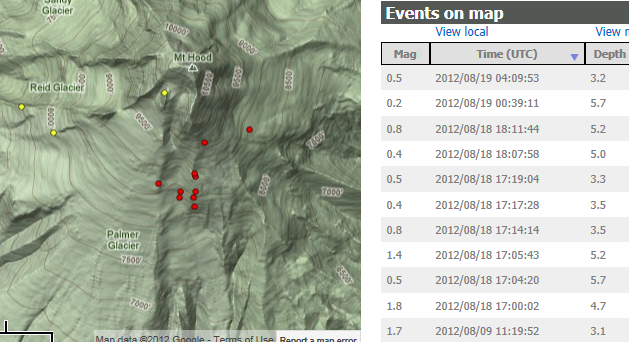
Total of 10 microquakes, depths ranging from 3.2 to 5.7 km.
Glad to have you watching.
It has been a while, but a new small swarm has emerged near Mt. Hood again. As in the past, it could be tectonic in nature, but since it is so near
the volcano, it's good to keep an eye on such events.

image from PNSN
Here is the spectrogram of the largest earthquake in this series (so far) a mag 2.3, 7.1 kms deep.
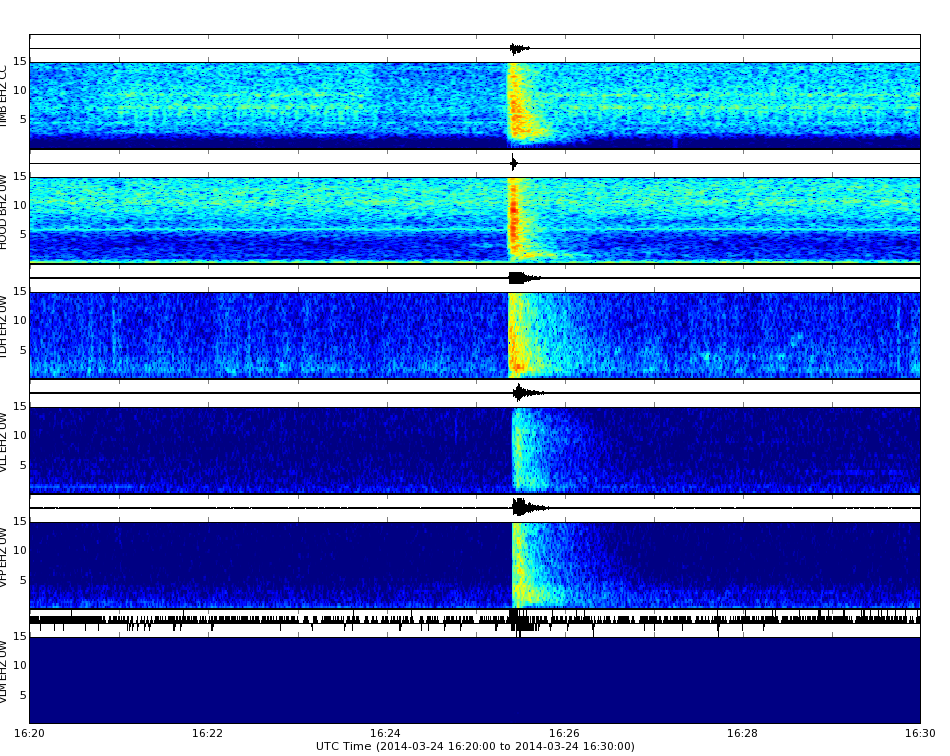
PNSN spectro
And finally, this is a link to a nearby seismograph station, TDH.UW.EHZ

image from PNSN
Here is the spectrogram of the largest earthquake in this series (so far) a mag 2.3, 7.1 kms deep.

PNSN spectro
And finally, this is a link to a nearby seismograph station, TDH.UW.EHZ
edit on 3/24/2014 by Olivine because: poor typing skills
Mount Hood had a tiny burst of confirmed volcanic earthquakes 9 days ago.
CVO
(I had to remove the (< 2 kms) portion from the quote, because it wouldn't code correctly)
The 3 largest were listed at less than 2.0 kms deep. Here is the link to the associated spectrograms, between 15:39 and 16:10 UTC.
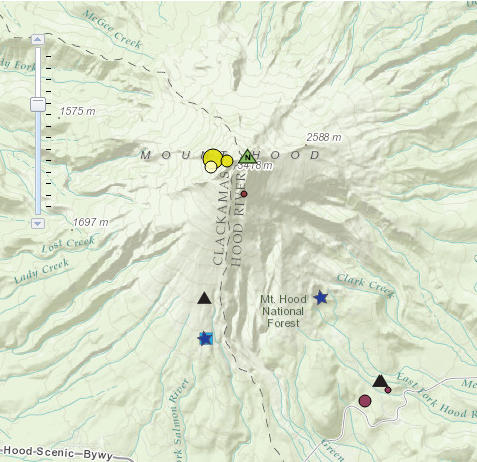
four shallow volcanic earthquakes at Mount Hood occurred on October 8 between 8:39 - 9:18 am local (PDT) with magnitudes 1.6, 0.3, 1.4, and 2.0.
CVO
(I had to remove the (< 2 kms) portion from the quote, because it wouldn't code correctly)
The 3 largest were listed at less than 2.0 kms deep. Here is the link to the associated spectrograms, between 15:39 and 16:10 UTC.

edit on 10/17/2014 by Olivine because: coding issue
new topics
-
whistleblower Captain Bill Uhouse on the Kingman UFO recovery
Aliens and UFOs: 4 hours ago -
1980s Arcade
General Chit Chat: 6 hours ago -
Deadpool and Wolverine
Movies: 7 hours ago -
Teenager makes chess history becoming the youngest challenger for the world championship crown
Other Current Events: 8 hours ago -
CIA botched its handling of sexual assault allegations, House intel report says
Breaking Alternative News: 9 hours ago -
Lawsuit Seeks to ‘Ban the Jab’ in Florida
Diseases and Pandemics: 11 hours ago
top topics
-
Lawsuit Seeks to ‘Ban the Jab’ in Florida
Diseases and Pandemics: 11 hours ago, 20 flags -
Starburst galaxy M82 - Webb Vs Hubble
Space Exploration: 13 hours ago, 13 flags -
The Superstition of Full Moons Filling Hospitals Turns Out To Be True!
Medical Issues & Conspiracies: 15 hours ago, 8 flags -
CIA botched its handling of sexual assault allegations, House intel report says
Breaking Alternative News: 9 hours ago, 8 flags -
15 Unhealthiest Sodas On The Market
Health & Wellness: 13 hours ago, 6 flags -
whistleblower Captain Bill Uhouse on the Kingman UFO recovery
Aliens and UFOs: 4 hours ago, 6 flags -
Teenager makes chess history becoming the youngest challenger for the world championship crown
Other Current Events: 8 hours ago, 3 flags -
Deadpool and Wolverine
Movies: 7 hours ago, 3 flags -
1980s Arcade
General Chit Chat: 6 hours ago, 3 flags
active topics
-
What is a dream
The Gray Area • 27 • : wrayth -
Europe declares war on Russia?
World War Three • 61 • : F2d5thCavv2 -
The Acronym Game .. Pt.3
General Chit Chat • 7741 • : F2d5thCavv2 -
Russia Ukraine Update Thread - part 3
World War Three • 5713 • : F2d5thCavv2 -
IDF Intel Chief Resigns Over Hamas attack
Middle East Issues • 32 • : Terpene -
15 Unhealthiest Sodas On The Market
Health & Wellness • 32 • : VariedcodeSole -
Fast Moving Disc Shaped UFO Captured on Camera During Flight from Florida to New York City
Aliens and UFOs • 18 • : inflaymes69 -
Definitive 9.11 Pentagon EVIDENCE.
9/11 Conspiracies • 419 • : SchrodingersRat -
They Killed Dr. Who for Good
Rant • 61 • : Cymru -
How ageing is" immune deficiency"
Medical Issues & Conspiracies • 26 • : RookQueen2
21
